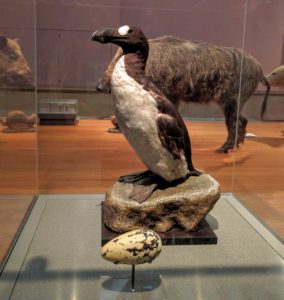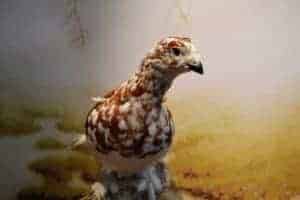Smølali grouse photographed at Hitra on Skjellandet near Jektvika, Ansnes.
Copyright photo: Ingolf Jektvik. The photograph is reproduced with the permission of the photographer.
The Norwegian Environmental Protection Association (NMF) has now sent a complaint to a number of ministries and authorities, as well as to the Nordic Council and the United Nations (which monitors the UN's Sustainable Development Goals).
We ask that Norway take care of its national and international responsibility to preserve the continued existence and future of the Smølalirype, and also suspend the County Governor's decision that repealed Frøya Municipality's decision.
Norway and the world are now in serious danger of exterminating a genetically unique bird that has adapted over thousands of years to a mild climate with snow-poor winters. The Smølalirypa is Norway's only endemic bird species, i.e. it is only found on a few islands off the Trøndelag coast in the whole world. Now its future is highly uncertain, and we now risk forever and ever losing it to the wind power industry. On Hitra these days even more wind turbines are being built, and on Frøya, Trønderenergi and their German majority owners Stadtwerke München have already started construction work with excavators, police and dynamite, in the middle of the nesting season. The black grouse, together with the black grouse, have had such a marked decline in recent years, without us knowing the reasons, that they have both been added to the red list. The Smølali grouse, with its geographically limited habitats, is much more vulnerable than the mainland grouse.
The islands off the coast of Nord Møre and Trøndelag are so separated from the mainland that, over thousands of years, a unique variant of the lily grouse has developed here. Smølalirypa, Lapogus lapogus variegatus (in some sources referred to as L. l. variegata) is a genetically unique subspecies of lyre grouse that differs from the mainland lyre grouse, among other things, in that it does not turn completely white in winter. The correct thing is that the grouse on Smøla seem to be more distantly related to the grouse on Hitra and even more so to Frøya, than to the mainland grouse. The grouse on Frøya are genetically the most distant from the mainland population, followed by the Hitra population. The grouse on Smøla now have a more uncertain genetic status. However, all three island populations show morphological differences from the nominate race on the mainland. Morphologically, the grouse on Frøya are farthest from the mainland grouse, especially in terms of pigmented winter coat and pigmentation of hand feathers.
Charles Darwin developed his theory of evolution precisely by studying how the geographically separated Galapagos Islands developed new species adapted to their unique environment and habitats. The islands of Smøla, Hitra, Frøya and Sula are warmed by the Gulf Stream and have a mild coastal climate with snow-poor winters. Over thousands of years, the Smølali grouse has adapted to the mild coastal climate by not getting a completely white winter coat like the mainland grouse. This local adaptation means that it has a camouflage that protects it from danger even in winters with little snow.
If we should now experience a milder climate with less snow on the mainland in the lirypa's liver areas, it will, with its white winter coat, become easy prey for birds of prey, foxes and other predators. The Smølalirypa is already adapted to such a climate, but is now in serious danger of becoming extinct. If climate change turns out to be a reality, the unique populations of black grouse may actually prove to be the salvation for the entire Scandinavian grouse population. In many ways, therefore, the last populations on Frøya and Hitra become Norway's own Noah's Ark that can save species diversity in a warmer climate. Then it becomes completely pointless to develop the wind industry where it has its habitats.

The experience from Smøla is that since the plant was put into operation, the wind turbines have killed around 100 sea eagles, 3 golden eagles and 200 Smølali grouse, and a number of other bird species. These are only the official numbers, and there are large dark numbers as there are large areas to search through, limited by capacity and frequency of searches, and there are many birds that are never found or are removed by flying or four-legged predators. Birds that are injured will in many cases be able to move far away from the turbine before they die a slow and painful death as a result of the injuries they suffer.
Here is a film from 2015 showing the search for birds around the turbines at Smøla:
Eagle carcass counting under wind turbines in Norway
The real number of birds killed can, based on the uncertainties described above, quickly reach double the official figures. With such a large death toll in contact with wind turbines, the status of the ptarmigan on Smøla is now very uncertain and poor. Weak populations are very susceptible to genetic dilution by immigration from the mainland and nearby islands. The wind turbines have proven to be a disaster for the Smølali grouse population on Smøla. Now the wind power in its habitats is being dramatically expanded at Hitra, and Trønderenergi with its German majority owners Stadtwerke München has now started construction work in its habitats. To excess with excavators and dynamite, in the middle of the nesting season, well protected by large police forces. Norwegian administration has here reached its absolute bottom. Smølalirypa has spent thousands of years developing its genetically unique adapted characteristics which the State of Norway and the wind power industry can now manage to eradicate within a few years. In 2019, we should certainly do infinitely better.

Trønderenergi and Stadtwerke München spend millions of kroner advertising their business under the slogan, "On our watch...".
On "our watch", they are now in the process of exterminating a genetically unique bird species that is already adapted to a mild and snow-poor climate. An adaptation and a genetic material that could be the very salvation for the entire Scandinavian lirypus population if climate change were to become a reality.
Our next vulture?
The vulture (Pinguinus impennis), which was once common in large numbers along the coasts on both sides of the Atlantic, from Greenland in the north to northern parts of Spain in the south, has now been officially extinct since 1844. Will the Smølalirypa now become our next vulture?

Trønderenergi and Stadtwerke München, together with the wind power companies at Smøla and Hitra, now hold the key to that answer. They are the ones who now hold the fate of the grouse in the palm of their hand. They and only they are now responsible for perhaps the biggest environmental crime in recent history. Extinction of a genetically unique species that is adapted to a warmer climate. Short-term pursuit of money. 25-year licence, use and disposal.
What will Trønderenergi and Stadtwerke München now say at future board meetings?
"On our watch" we made the smoela grouse Norway's new vulture...
This responsibility also rests in particular on the shoulders of our Norwegian authorities, there
It becomes extra special when it shows you that both the county governor in Trøndelag and the management in the licensing department of NVE has far too close links to directors in the developer company Trønderenergi.
The state of Norway is bound by its own legislation and a number of international agreements and treaties. What is happening now with the massive wind power developments is directly contrary to these, and Norway is not taking its responsibility as an administrative authority or as a rule of law. §112 of the Constitution, the Natural Diversity Act and more have been effectively set aside by the Energy Act, which now trumps everything in the biggest destruction of nature in Norwegian history. The Norwegian Environment Protection Association takes this seriously and will fight this issue at all levels and in all ways. Norway's history as one of the first and most significant rule of law in Europe has, through today's environmental management, now become virtually lawless. Laws and regulations that are supposed to take care of and protect are effectively disregarded, and international agreements and treaties, such as the Bern Convention and the UN's Sustainable Development Goals, are not followed. This is serious and we are now losing irreplaceable natural values and destroying people's local environment and destroying local communities in the short-term rush for money, subsidies and symbolic politics.
What a symbolic policy we are now going to show to the rest of the world, where we ourselves are pursuing a policy that puts the very survival of a uniquely genetically adapted bird in serious danger of extinction. The species that has already adapted to the predicted climate changes. What are we about to do now?

Should future generations only get to experience the ruffed grouse, stuffed in a glass case side by side with the vulture in a museum?
The State of Norway has a special responsibility to stop the ongoing wind power development on Frøya, and also on Hitra and Smøla. We already have the tools in Norwegian law and in the UN's Sustainability Goals, which we are affiliated with and have signed. Anything else would be a serious negligence and serious environmental crime.
Norwegian authorities MUST act NOW!
Tomorrow is too late…
![]() Download our report/complaint here.
Download our report/complaint here.





